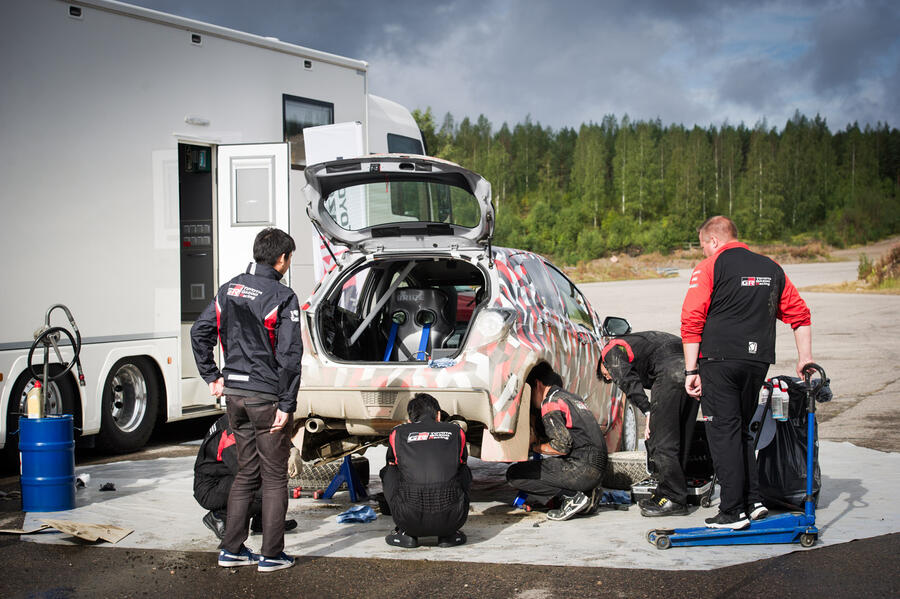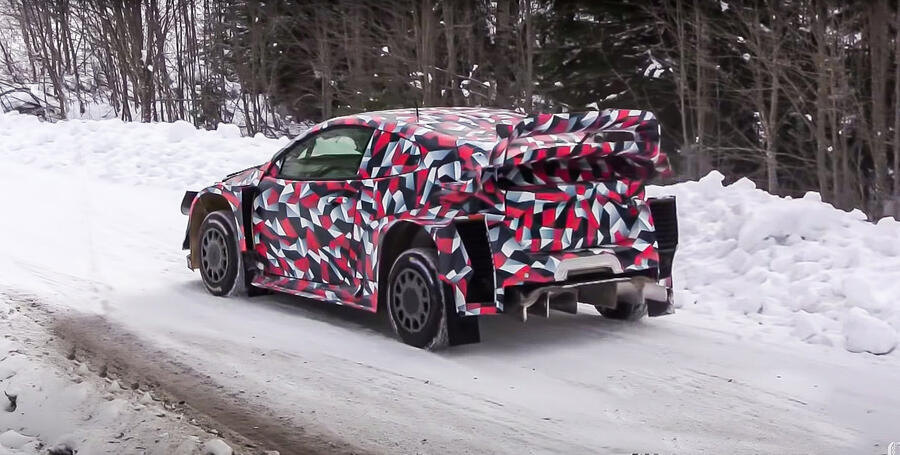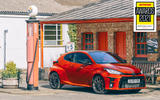From the moment Autocar first sat in a prototype version of the Toyota GR Yaris – in the simpler times of December 2019 – we had a sense it would do well in the world’s most comprehensive road test.
That feeling was heightened after our first drive of the finished car, and again when it outstripped the Honda Civic Type R, Ford Fiesta ST and Volkswagen Golf GTI to claim our Britain’s Best Affordable Driver’s Car crown in November last year. But nothing was certain until our expert road testers took the GR Yaris to Millbrook for the most extensive and exhaustive test process going. Still, when the white smoke that signals an ultra-rare five-star verdict finally rose from the secret bunker in which our testers debate their scores, we doubt many people were all that surprised.
But it turns out that some very important people were: Toyota’s Gazoo Racing team, which had developed the hot hatch. “We appreciated your kind words, but in my humble opinion we can never achieve the perfect car,” says chief engineer Naohiko Saito. “We had to start from scratch with this car, and we’d lost 20 years of experience. So this is just the start of development for our sports car. The important thing now is just to keep making it better for the future.”
It’s worth remembering that while the GR Yaris is now virtually shorthand for hot hatch brilliance, that was by no means certain during its development. In fact, the very idea of the world’s largest car company, one with a reputation for building staid, sensible models (and hybrids), transforming the solidly dependable Yaris into a four-wheel-drive homologation-special pocket rocket still seems faintly absurd.

That it happened is testimony not only to the Gazoo Racing engineers and the firm’s World Rally Championship team but also to the support of the wider company – going right to the top. While part of the impetus for the GR Yaris was to provide the base for the next-generation Yaris WRC, the main driving force was company boss Akio Toyoda’s determination to prove that Toyota could develop a world-class performance car in-house. He had already led Toyota’s return to performance cars with the GR Supra and GT86 (now GR 86), but he wanted to take that to the next level.
“He wanted to show that we could put learning from motorsport into our road cars,” says Saito. “His passion to produce a sports car ourselves and make it in our own plant was key to development.”
Toyoda, a regular competitor in races and rallies, didn’t just deliver a demanding brief and leave Gazoo Racing to get on with it: he was involved throughout the four-year development. While Saito’s job title is GR Yaris chief engineer, he prefers to give that title to Toyoda. “I would describe it as leading the project,” he adds. “He discussed every aspect of the car with us, and took decisions on many final specs.”
It was also Toyoda who pushed the close relationship between Gazoo Racing’s Japanese engineers and Tommi Mäkinen Racing, the Finnish firm run by the four-time world champion that oversaw Toyota’s WRC operation at the time.
“Toyoda-san sent us to Finland, and we had a series of deep discussions with the rally team about how to develop a sports car using race and rally car technology,” says Saito. “They visited Japan at least four times a year and we went to Finland many times. We learned so much from them.
“From the start, we foresaw the GR Yaris as a future homologation car, so we discussed what they wanted from that, about a low roofline to improve the aerodynamics and a low body weight. They had a big motivation and were excited to be involved with developing a road car.”

The rally team also helped Saito’s team develop knowledge in areas where it was lacking experience – particularly in the GR Yaris’s four-wheel drive system. It had been more than 20 years since Toyota last developed a high-performance all-wheel drive system, for the Toyota Celica GT-Four that went out of production in 1999. “There was nobody left in the company we could ask about it,” says Saito. “We found the technical reports from the development of the GT-Four, but the person who had signed off on it was retired. So we had to start from scratch. We just didn’t have the knowledge. I think development of this type of technology has to be continuous and never stop.”
The realisation of how much work Toyota needed to do on its four-wheel-drive drivetrain apparently came when the firm’s WRC drivers – including now team chief Jari-Matti Latvala – sampled a prototype of the GR Yaris for the first time. By all accounts, that early test hack was so raw that it was borderline impossible to drive. Is that true?
“Yes, this is fact,” says Saito with a laugh. “The rally drivers helped teach us how to manage torque distribution. Latvala-san and Mäkinen-san could tell us how to manage four-wheel drive on surfaces such as snow and rain and Tarmac, and the changes we needed to make for each surface. That was key to the development of the GR4 system.”
That electronically controlled all-wheel drive system eschews a centre differential (it would have been too heavy) for a high-performance coupling in front of the rear axle. In various drive modes it can send 60% of the power to the front and 40% to the rear (default mode), 50:50 (Track) and 30:70. It is combined with a manual handbrake that automatically disconnects the rear shafts when pulled.
Toyota’s WRC stars weren’t the only test drivers, of course. As noted, Toyoda was involved in every step of the development and drove every test hack and machine.

“He didn’t care if the prototype was difficult to control or may be dangerous,” says Saito. “He never gave up. He broke the car, and we fixed it. And then he tested it again. He didn’t just break the bodywork; he broke the transmission and he broke the driveshaft also.”
To be clear, there’s no suggestion that Toyoda lacks mechanical sympathy or skills behind the wheel. Instead, this was a deliberate testing cycle inspired by the development of race and rally cars. “This was a really important process,” says Saito. “It was key to making it stronger. In motorsport, a vehicle has to be driven in the most severe conditions. During the GR Yaris development, Toyoda-san asked us to repeat the cycle: break it, fix it, make it stronger. In future, we can apply this development process to other models, including GR models and other Toyota models.”
With the guidance of Toyoda and the WRC team, the GR Yaris began to take shape as a vehicle unlike anything else Toyota produces. That individuality goes beyond the all-wheel drive system: the platform is a unique fusion of Toyota’s GA-B and GA-C platforms that has been designed to accommodate double-wishbone rear suspension, and the all-new, 258bhp 1.6-litre turbocharged engine is intended to allow for a future second-tier WRC2 competition car.
Then there’s the lightweight bodyshell, which uses virtually nothing from the standard Yaris and makes copious use of aluminium and forged-carbon composite. At the behest of the rally team, to aid with homologation of the 2022 Rally1 Yaris, the roofline was lowered, a spoiler was added and the GR Yaris has just three, rather than five, doors.
While the design and final engineering may have come from Gazoo Racing, those design features and technologies would not have been possible without the help of the wider Toyota company. “The powertrain department really worked on the engine, and the material engineering aided us with the lightweight body,” explains Saito. “The electrical systems and production engineers also provided amazing help.
“We didn’t have many of the technologies we needed in-house, so everyone put in remarkable efforts to help us achieve the performance we wanted – and for an affordable cost.”
That ‘affordable cost’ point is significant, and particularly so given the expense of developing such a singular car, one that will never sell in the sort of volumes for which the world’s biggest car maker would normally aim. But the company accountants are likely to be the only people who are, at worst, mildly unhappy with the result.

Frankly, you can tell the GR Yaris is right just by admiring its Yaris-on-steroids, rally-special hot hatch bodywork, or by prodding its genuinely flexible lightweight bumper. And, as its double Autocar Awards success shows, it doesn’t disappoint when you drive it.
You can see how happy Saito is with the finished product. He’s particularly proud of how little the car weighs: “There were so many efforts from engineers and suppliers to make it as light as possible: the lightest body with aluminium and carbon, the lightest engine, the lightest four-wheel drive system. We overcame so many challenges.”
So the moment when Toyoda finished the final test of the final prototype and officially signed off on the GR Yaris for production must have been a pretty good one, no?
“To tell you the truth, I understood that this was not really the final approval,” says Saito. “Akio Toyoda wants to keep improving cars. “What he gave us was just an ‘okay’ sign on the way. It was an approval to go with starting sales and to move on to the next step, to get approval and feedback from road customers and motorsport competitors, that we can use for the development of future cars."
Because, of course, as far as Saito is concerned, the GR Yaris isn’t a perfect car. In fact, there’s more to come. “We’re now not just getting feedback from rallies, but customers doing gymkhana and races and rally raids,” he says. “We are learning from them about how they want to use the four-wheel-drive torque distribution or align the suspension. And we’re continuing to race it, so we can continue to make it stronger.”
Excitingly, Saito says his team has a list of ways to improve the GR Yaris in the future. How many items are on that list? “I couldn’t count,” laughs Saito. “There are so, so many. We lost 20 years of development. And we’re only just starting.”
Yaris's alternative future
With its turbocharged petrol engine, the Toyota GR Yaris is almost a throwback in an age of electrification – and one largely enabled by Toyota’s hybrid car sales success, which keeps its average fleet emissions low.
Toyota is developing electric cars, too, along with other alternative fuels such as hydrogen. And it’s hydrogen that the firm is hoping the GR Yaris can use to help secure the combustion engine’s future in an emission-free world. The firm recently developed a Corolla race car, which uses a version of the GR Yaris’s 1.6-litre engine specially converted to run on hydrogen.
“Akio Toyoda loves engines,” says Naohiko Saito. “He loves old Ferraris and motorsport cars, and he wants to continue having exciting sports cars with exciting noises.”
READ MORE
Autocar Awards 2021: all the winners
Autocar Awards 2021: Hyundai Chairman Euisun Chung wins Issigonis Trophy​
Autocar Awards 2021: Polestar's Thomas Ingenlath wins Sturmey Award
Promoted | How Britishvolt is electrifying the UK car industry































Join the debate
Add your comment
It sounds like Toyoda is a bit too enthusiastic for the commercial good of the company. Long may it continue!